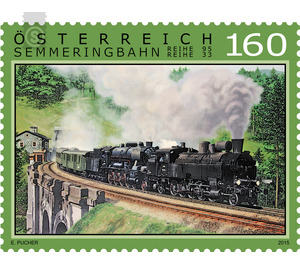railroad - Austria / II. Republic of Austria 2015 - 160 Euro Cent
Theme: Traffic, Transportation & Mobility
| Country | Austria / II. Republic of Austria |
| Issue Date | 2015 |
| Face Value | 160.00 |
| Edition Issued | 200,000 |
| Printing Type | Combination printing, offset stitch (Etch-Art by OeSD) |
| Stamp Type | Commemorative |
| Item Type | Stamp |
| Chronological Issue Number | 2570 |
| Chronological Chapter | OOS-OE2 |
| SID | 23403 |
| In 71 Wishlists | |
The Semmering Railway, which was built under the direction of Carl Ritter von Ghegas from 1848 to 1854 and is now a World Heritage Site, was an outstanding engineering achievement at the time of its creation, which could be based on only a few previously implemented but far more modest models. The technical, geological and organizational difficulties that had to master the planner and builder were gigantic, it was still a solid railroad track without cables or other obstructive for continuous train traffic devices to pass through a wild rugged mountain landscape to the lowest alpine pass between Vienna and to overcome the then Austrian port of Trieste - a project considered by many to be unrealizable at the time. Nevertheless, Ghega mastered the gap in the rail line within only six years and thus created a model for mountain railways all over the world. The long incline ramp and the tight bends certainly demanded the highest performance from the locomotives. Initially, special mining locomotives were used for this purpose, but after the rapid growth of the train weights, additional reinforcement by prestressing and sliding locomotives, which were kept ready in Gloggnitz and Mürzzuschlag, became necessary. The over the Höllgrabenviadukt rolling D-train had the classic covering with train locomotive of the row 33 and prestressing locomotive of the row 95 is certain: A steam train in the wildly romantic Semmering landscape was for a hundred years a much admired spectacle, with the electrification this finally came to an end.


